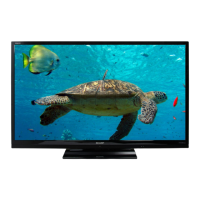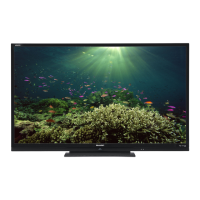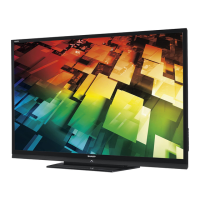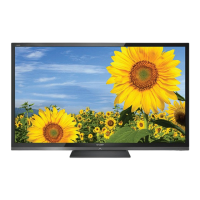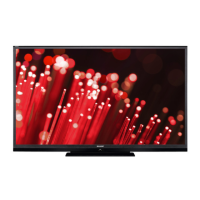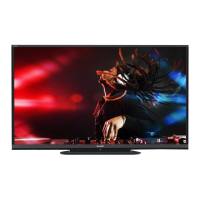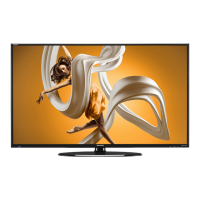Do you have a question about the Sharp Aquos LC-60LE630X and is the answer not in the manual?
Instructions for cleaning, water avoidance, and stable placement.
Importance of proper ventilation and safe practices for moving the TV.
Trademarks for SRS, HDMI, Dolby, DivX, and ENERGY STAR.
Verify screws and attach the supporting post to the TV stand base.
Insert the stand into the TV and attach the stand cover securely.
Verify screws and attach the supporting post to the TV stand base.
Insert the stand into the TV and attach the stand cover securely.
Allows rotation of the TV screen up to 15 degrees left or right.
Guide for connecting an outdoor or room antenna to the TV.
Connect VCRs, game consoles, and camcorders using composite or component cables.
Connect DVD players, Digital TV STBs, and PCs via HDMI or PC terminals.
How to output audio through the digital audio output terminal.
Explains the function of each button on the remote control unit.
Step-by-step guide for installing batteries in the remote control.
Identifies key components, indicators, and terminals on the TV.
Notes on connecting and using headphones with the TV.
Instructions for turning the TV on, off, and entering standby mode.
Steps to enable antenna power for optimal DTV reception.
Guides the user through the first-time TV setup process.
How to check signal strength for proper antenna alignment.
Use signal strength and quality to align the antenna correctly.
Instructions to perform the auto installation again after initial setup.
Configure DTV services and perform automatic channel searches.
Manually search and adjust digital channels and services.
Rearrange analogue channel order and delete unwanted programmes.
Perform automatic channel search and manual adjustments for analogue TV.
Adjust frequency, colour system, and sound settings for analogue channels.
Configure sound, channel labels, booster, skip, and lock features.
Procedures for reordering and removing analogue TV channels.
Choose optimal viewing settings for different input sources and environments.
Step-by-step guide on how to operate the TV's menu interface.
Adjust backlight, contrast, brightness, colour, tint, and sharpness.
Adjust white balance and use special modes like Quick Shoot and Film Mode.
Configure treble, bass, balance, and SRS TruSurround HD sound.
Configure automatic power-off features for energy saving.
Set up child lock and manage the password for secure settings.
Restrict channels by rating and skip input sources during selection.
Assign names to inputs and adjust picture horizontal/vertical position.
Automatically adjust wide mode and screen format using signal information.
Configure audio input for PC/HDMI and select output volume control.
Equalize audio levels and enhance speech clarity automatically.
Select digital audio format and enable audio-only playback.
Display game time and select compatible colour systems.
Automatically and manually adjust PC image for optimal display.
Switch subtitle languages and display for hearing impaired.
Set preferred multi audio languages for available broadcasts.
Configure time zone, summer time, and software update settings.
Access programme guide and schedule future viewing reminders.
View extended programme information using the INFO button.
Switch between Analogue TV, Digital TV, and Radio broadcast modes.
Run auto installation to set up analogue channels automatically.
Change audio modes for stereo, bilingual, and monaural broadcasts.
Select and switch between different audio formats for A2 TV broadcasts.
View, cancel reminders, and freeze the TV screen image.
Configure screen aspect ratio and automatic wide mode settings.
Freeze pictures and manually select desired screen aspect ratios.
Use WSS for auto mode or manually choose picture sizes.
Turn Teletext on/off and understand the function of Teletext buttons.
Control TV functions remotely from a PC using RS-232C.
Information on supported PC resolutions and video standards.
Reference for commands to control the TV via RS-232C connection.
Steps to connect USB storage and overview of media playback features.
Choose between photo viewing, music playback, and video watching.
How to select, play, and control video files from a USB device.
Explanation of buttons used for full-screen video playback.
How to select, play, and control music files from a USB device.
How to select, view, and control photos from a USB device.
Register for DivX VOD, confirm codes, and deactivate services.
List of compatible photo, music, and video file types for USB playback.
Solutions for issues like no power, no picture, or no sound.
Guidelines for using the TV in varying temperature conditions.
Details on LCD panel, resolution, video systems, and audio amplifiers.
Information on TV connections, power usage, size, and weight.
Recommended operating conditions and available accessories.
Instructions for securing the TV to prevent overturning.
Instructions for securing the TV to prevent overturning.
Steps to remove the stand for wall mounting on specific models.
Steps to remove the stand for wall mounting on specific models.
Details on compatible wall mounts and installation process.
Adjusting the TV's viewing angle after it has been wall-mounted.
Detailed physical measurements for the LC-40LE530X model.
Detailed physical measurements for the LC-46LE530X model.
Detailed physical measurements for the LC-60LE630X model.
Procedure to reset the TV's password if it is forgotten.
Instructions for cleaning, water avoidance, and stable placement.
Importance of proper ventilation and safe practices for moving the TV.
Trademarks for SRS, HDMI, Dolby, DivX, and ENERGY STAR.
Verify screws and attach the supporting post to the TV stand base.
Insert the stand into the TV and attach the stand cover securely.
Verify screws and attach the supporting post to the TV stand base.
Insert the stand into the TV and attach the stand cover securely.
Allows rotation of the TV screen up to 15 degrees left or right.
Guide for connecting an outdoor or room antenna to the TV.
Connect VCRs, game consoles, and camcorders using composite or component cables.
Connect DVD players, Digital TV STBs, and PCs via HDMI or PC terminals.
How to output audio through the digital audio output terminal.
Explains the function of each button on the remote control unit.
Step-by-step guide for installing batteries in the remote control.
Identifies key components, indicators, and terminals on the TV.
Notes on connecting and using headphones with the TV.
Instructions for turning the TV on, off, and entering standby mode.
Steps to enable antenna power for optimal DTV reception.
Guides the user through the first-time TV setup process.
How to check signal strength for proper antenna alignment.
Use signal strength and quality to align the antenna correctly.
Instructions to perform the auto installation again after initial setup.
Configure DTV services and perform automatic channel searches.
Manually search and adjust digital channels and services.
Rearrange analogue channel order and delete unwanted programmes.
Perform automatic channel search and manual adjustments for analogue TV.
Adjust frequency, colour system, and sound settings for analogue channels.
Configure sound, channel labels, booster, skip, and lock features.
Procedures for reordering and removing analogue TV channels.
Choose optimal viewing settings for different input sources and environments.
Step-by-step guide on how to operate the TV's menu interface.
Adjust backlight, contrast, brightness, colour, tint, and sharpness.
Adjust white balance and use special modes like Quick Shoot and Film Mode.
Configure treble, bass, balance, and SRS TruSurround HD sound.
Configure automatic power-off features for energy saving.
Set up child lock and manage the password for secure settings.
Restrict channels by rating and skip input sources during selection.
Assign names to inputs and adjust picture horizontal/vertical position.
Automatically adjust wide mode and screen format using signal information.
Configure audio input for PC/HDMI and select output volume control.
Equalize audio levels and enhance speech clarity automatically.
Select digital audio format and enable audio-only playback.
Display game time and select compatible colour systems.
Automatically and manually adjust PC image for optimal display.
Switch subtitle languages and display for hearing impaired.
Set preferred multi audio languages for available broadcasts.
Configure time zone, summer time, and software update settings.
Access programme guide and schedule future viewing reminders.
View extended programme information using the INFO button.
Switch between Analogue TV, Digital TV, and Radio broadcast modes.
Run auto installation to set up analogue channels automatically.
Change audio modes for stereo, bilingual, and monaural broadcasts.
Select and switch between different audio formats for A2 TV broadcasts.
View, cancel reminders, and freeze the TV screen image.
Configure screen aspect ratio and automatic wide mode settings.
Freeze pictures and manually select desired screen aspect ratios.
Use WSS for auto mode or manually choose picture sizes.
Turn Teletext on/off and understand the function of Teletext buttons.
Control TV functions remotely from a PC using RS-232C.
Information on supported PC resolutions and video standards.
Reference for commands to control the TV via RS-232C connection.
Steps to connect USB storage and overview of media playback features.
Choose between photo viewing, music playback, and video watching.
How to select, play, and control video files from a USB device.
Explanation of buttons used for full-screen video playback.
How to select, play, and control music files from a USB device.
How to select, view, and control photos from a USB device.
Register for DivX VOD, confirm codes, and deactivate services.
List of compatible photo, music, and video file types for USB playback.
Solutions for issues like no power, no picture, or no sound.
Guidelines for using the TV in varying temperature conditions.
Details on LCD panel, resolution, video systems, and audio amplifiers.
Information on TV connections, power usage, size, and weight.
Recommended operating conditions and available accessories.
Instructions for securing the TV to prevent overturning.
Instructions for securing the TV to prevent overturning.
Steps to remove the stand for wall mounting on specific models.
Steps to remove the stand for wall mounting on specific models.
Details on compatible wall mounts and installation process.
Adjusting the TV's viewing angle after it has been wall-mounted.
Detailed physical measurements for the LC-40LE530X model.
Detailed physical measurements for the LC-46LE530X model.
Detailed physical measurements for the LC-60LE630X model.
Procedure to reset the TV's password if it is forgotten.
